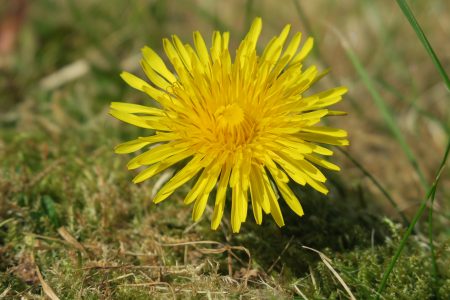
Photo credit: Grace Bettayeb
At this point in the year, I’d imagine anyone who likes a manicured lawn is sick of seeing a certain stubborn yellow flower pop up all over their grass. However dandelions are a valuable native wildflower and have much to offer wildlife and us. Dandelions are useful and industrious plants that we should all be more grateful for.
Dandelions (or species in the genus Taraxacum) are small flowers in the same family as sunflowers. Their distinctive bright yellow flowerheads and fluffy grey seed heads make them easy to spot from a distance. Up close, their leaves are pretty unique as well, hugging very close to the ground to maximise the space the dandelion claims for itself. The leaves also have a pointed toothlike edge, which is where their common name comes from. “Dent-de-lion”–French for “lion’s tooth”.
In spring, the bright yellow flowers start popping up all over the place. Once they’ve been pollinated, the flowerhead changes to the characteristic fluffy seed head, which is known by many names, but most commonly called a dandelion “clock”. Supposedly, you can tell the time by counting how many times you need to blow on the head to get all the seeds to fly away. While the dandelions probably don’t know what time it is, I’m sure they appreciate the help in dispersing their seeds.
Dandelions are considered a weed by many people, probably because the plants are incredibly resilient. They grow almost anywhere, including in cracks in road cement, are nearly always in flower, and start blooming early in the spring without stopping until autumn. Cold weather doesn’t do much more than slow them down a bit.
While people trying to keep manicured lawns might not like dandelions, the natural world is much happier to have them around. Dandelions are among the first wildflowers to bloom each year, making them an ideal food source for the first pollinators emerging from hibernation. Although the nectar and pollen of the dandelion are lacking a few key nutrients, it’s more than enough to tide the pollinators over until other wildflowers begin to bloom, and remains an important part of their diet throughout the season.
Other plants appreciate the dandelion for its long taproot. While the flat, spreading leaves of the dandelion are specially adapted to smother any competition trying to grow right next to them, the plant’s root reaches much further into the soil than any of its neighbours, drawing up water and nutrients that would otherwise be inaccessible. By pulling those deep treasures up and using them for itself, the dandelion will eventually return those nutrients to the top layer of soil where other plants can access them.
Ancient humans also understood the value of dandelions. Every part of the plant, from its root to its flower, is edible. The leaves are called ‘dandelion greens’ and many human cultures throughout Eurasia have used them as food starting from ancient times and going right up to the modern day, where the leaves are still a common food in Greece. Dandelions are also used for traditional herbal medicine, where they’re said to be good for everything from nausea to hemorrhoids. Dandelions are sometimes called ‘pissybeds’ or ‘pee-the-beds’, since the root has very strong diuretic properties.
As well as being good to eat, a caffeine-free coffee substitute can be made by grinding dandelions up. The plant also features in dandelion wine, traditional English soft drinks, and is a key ingredient of root beer. It’s even possible to make natural rubber from dandelions (although not from any of the species found in Ireland), as they produce a lot of latex, which is a milky white substance that serves a defensive function similar to tree sap. On the more fanciful side, it’s said that catching a flying dandelion seed, whispering a wish to it, and then letting it fly off again will cause your wish to be carried away and hopefully be granted.
With all these uses, it’s hard to think of dandelions as being a simple weed. Arguably their most important use for us is as a food source for pollinating insects. The more dandelions there are, the better, especially early in the year when emerging bumblebee queens need food to survive on as they search for places to build their nests. That’s why it’s so important not to cut your grass too early, and to leave as many dandelions as possible out on your lawn. The bees, butterflies, and of course the dandelions themselves will all thank you for it.
By Grace Bettayeb